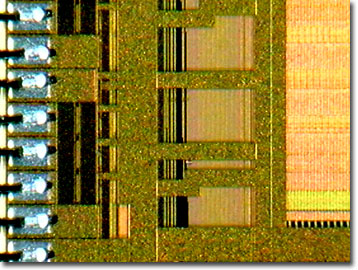Integrated Circuit Image Gallery
Pentium II Microprocessor
Joining the fifth generation of microprocessors, along with the Pentium Classic, MMX, and Pro versions, Intel engineers released the Pentium II (code-named Klamath) in 1997 for applications in high-end desktops, workstations, and network servers. This speedy microprocessor featured an astounding 7.5 million transistors, which were placed on a 203-square-millimeter silicon die utilizing 0.35 micron linewidth fabrication technology.

View a second image of the Pentium II processor.
The Pentium II doubled the level 1 primary cache memory (32 Kbytes versus 16 Kbytes each for instructions and data) and featured new segment register caches that improved the processing of 16-bit code, compared to the older Pentium Pro. These improvements helped the processor compete effectively in a market that was still dominated by the Windows 95 operating system.
Perhaps the main goal of replacing the Pentium Pro with the Pentium II (having clock speeds of 233, 266, and 300 MHz) was to reduce production costs. By eliminating the speedy integrated Pentium Pro secondary cache, and replacing it with a 512-Kbyte secondary cache that ran at half the processor's speed, Intel effectively cropped competition from rivals AMD and Cyrix. In order to further reduce compatibility with competing processors from other manufacturers, the Pentium II was packaged into a single-edge cartridge (SEC) designed for a newly patented Slot 1 motherboard connector. In 1998, the release of 333 MHz Pentium II versions, code-named Deschutes, heralded the first serious utilization of 0.25-micron linewidth fabrication technology. The 333 MHz Pentium II was followed by the 350 MHz and 400 MHz versions that employed a newer 100 MHz system bus for increased processing speed.
Contributing Authors
Omar Alvarado, Thomas J. Fellers and Michael W. Davidson - National High Magnetic Field Laboratory, 1800 East Paul Dirac Dr., The Florida State University, Tallahassee, Florida, 32310.
BACK TO THE INTEGRATED CIRCUIT IMAGE GALLERY
BACK TO THE DIGITAL IMAGE GALLERIES
Questions or comments? Send us an email.
© 1995-2025 by Michael W. Davidson and The Florida State University. All Rights Reserved. No images, graphics, software, scripts, or applets may be reproduced or used in any manner without permission from the copyright holders. Use of this website means you agree to all of the Legal Terms and Conditions set forth by the owners.
This website is maintained by our
Graphics & Web Programming Team
in collaboration with Optical Microscopy at the
National High Magnetic Field Laboratory.
Last Modification Friday, Nov 13, 2015 at 01:19 PM
Access Count Since September 17, 2002: 12593
Visit the website of our partner in introductory microscopy education:
|
|
